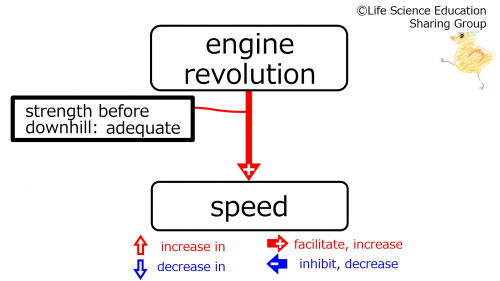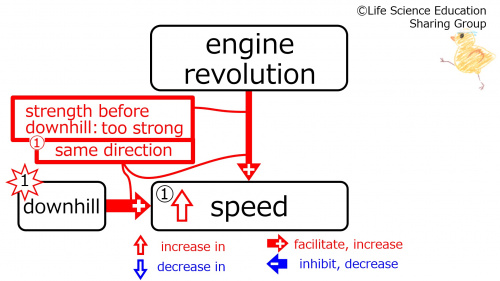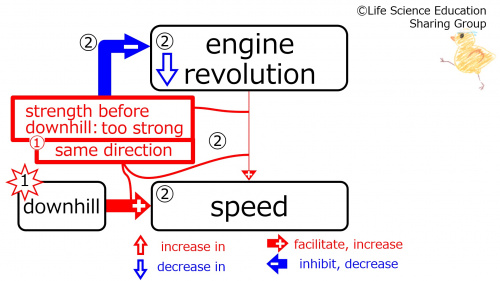「Introduction/NegativeFeedback(MiddleLevel)/CarDownhill」の版間の差分
編集の要約なし |
細 (Admin がページ「Introduction/negative feedback (basic level)/car engine at a downhill」を「Introduction/negative feedback (middle level)/car engine at a downhill」に、リダイレクトを残さずに移動しました) |
(相違点なし)
| |
2019年11月27日 (水) 23:42時点における版
| With water intake the plasma osmolarity decreases, and negative feedback decreases the synthesis, secretion, and blood concentration of vasopressin (anti-diuretic hormone, ADH). |
Before water intake (at baseline), we will make the assumption that the subject is in homeostasis with adequate strength of the plasma osmolarity-decreasing effect of reabsorption (through the water channels, which are increased by vasopressin, ADH) as well as normal plasma and urine osmolarities (isotonic) and urine volume.
Step 1: With water intake, water enters the plasma and osmolarity decreases (becomes hypotonic).
Step 2: This is in the same direction as the plasma osmolarity-decreasing effect of the reabsorption (through the water channels, which are increased by vasopressin, ADH). Thus, although the strength of the plasma osmolarity-decreasing effect of reabsorption (through the water channels, which are increased by vasopressin, ADH) was adequate before water intake (at baseline), this strength is now too strong (red) to reverse the low plasma osmolarity (hypotonic plasma) produced by water intake. Control by negative feedback is needed.
Step 3: With the strength of the plasma osmolarity-decreasing effect of the reabsorption (through the water channels, which are increased by vasopressin, ADH) before water intake (at baseline) being too strong (red), the negative feedback decreases (blue) (the synthesis, secretion, and blood concentration of) vasopressin (ADH).
Step 4: The water channel-increasing effect of vasopressin (ADH) becomes weaker, which decreases the number of water channels. This decreases the reabsorption of water by the kidney.
Step 5: With the decrease in water reabsorption, concentrated (hypertonic) solution enters the plasma. This increases plasma osmolarity. This will lead to a reverse in the decreased plasma osmolarity from water intake (hypotonic plasma), increasing it towards normal (baseline) osmolarity (isotonic plasma). Because concentrated (hypertonic) solution leaves the tubule due to reabsorption, the fluid remaining in the tubule has a lower osmolarity (hypotonic). Also, with the decrease in water reabsorption, there is more water remaining in the tubule. Overall, the urine becomes more diluted (hypotonic) and higher in volume.
Challenge Quiz
With water intake, negative feedback increases decreases the synthesis, secretion, and blood concentration of vasopressin (anti-diuretic hormone, ADH).
With water intake, negative feedback increases decreases the number of water channels in the kidney.
With water intake, negative feedback increases decreases water reabsorption by the kidney.
With water intake, negative feedback increases decreases urine volume.
With water intake, negative feedback increases decreases urine osmolarity.
With water intake, negative feedback increases decreases plasma osmolarity.
With water intake, water enters leaves the plasma and osmolarity increases decreases . This is in the same direction as opposite direction to the plasma osmolarity-decreasing effect of the reabsorption (through the water channels, which are increased by vasopressin, ADH). Thus, although the strength of the plasma osmolarity-decreasing effect of reabsorption (through the water channels, which are increased by vasopressin, ADH) was too strong adequate too weak before water intake (at baseline), this strength is now too strong adequate too weak to reverse the low plasma osmolarity produced by water intake. The negative feedback increases decreases (the synthesis, secretion, and blood concentration of) vasopressin (ADH). The water channel-increasing effect of vasopressin (ADH) becomes stronger weaker , which increases decreases the number of water channels. With the increases decrease in water reabsorption by the kidney, concentrated diluted solution enters the plasma. This increases decreases plasma osmolarity. This will lead to in the increased decreased plasma osmolarity from water intake, increasing decreasing it towards separate from normal osmolarity. Because concentrated diluted solution leaves the tubule due to reabsorption, the fluid remaining in the tubule has a higher lower osmolarity. Also, with the increase decrease in water reabsorption, there is more less water remaining in the tubule. Overall, the urine becomes more concentrated diluted and higher lower in volume.



